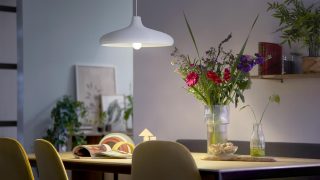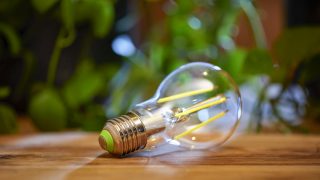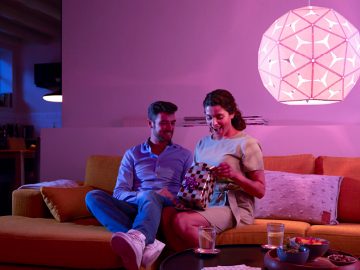Explore our range of LED lights, the energy-efficient, long-lasting, and environmentally-friendly lighting solutions. Discover how to choose the best option for every home space.
Why Philips lighting?

Energy-efficiency
Our UltraEfficient lights help reduce environmental impact by consuming less energy,¹ offering longer lifecycles,² and using over 80% paper-based materials in their packaging.

Comfort
Our indoor lights are gentle on the eyes³ and deliver ideal lighting output. Experience soothing illumination that genuinely cares for your wellbeing.

Convenience
Our lights are designed to make your life easier and brighter. They're easy to install and super easy to use.

Quality
Our lights are built to last, made of high-quality LEDs with durable and rigorously-tested materials.⁴

Design
Philips offers a wide range of lighting options that can match and enhance the style of your home and help you find the perfect ambiance to improve and accentuate your life within it.
Fixtures with LED technology


Ambient Lighting
Provides general room lighting and creates the perfect ambience.

Task Lighting
Provides the right level of brightness for specific tasks such as reading, cooking, working, folding the laundry…

Accent Lighting
Highlights certain objects you want to stand out: unique decor, plants, or artwork that you want to accentuate.
How to choose LED bulbs

Bulb Brightness
The level of brightness you want for your room. The higher the number, the more light you will get.

Caps and shapes
A wide range of caps in diverse shapes and sizes, crafted to fit seamlessly into any setting. Whether you're upgrading your home or personalising your space, we have the perfect cap to suit your needs.

Color temperature
Choose the perfect lighting for your space! Our LED solutions offer colour temperatures ranging from 3000K to 6500K. For a cosy, warm glow, go with 3000K. If you prefer a bright, cool white light, then 6500K is the way to go.

Setting the Mood
Easily change a room's ambiance by choosing a dimmable LED bulb. Our bulbs can be dimmable from between 10%-100%.
Our LED tech features

Experience true colours
Brighten up your home and bring colours to life with Philips LED lights. With a high Colour Rendering Index (CRI), our LEDs make everything look vibrant and true to their natural colour. In addition, the light stays consistent throughout the bulb's long lifespan, so you’ll be able to enjoy gorgeous lighting for many years to come.

Discover the versatility of dimmable lights
Our LED solutions come in all sorts of colours and styles, making them perfect for any spot in your home. From cosy evenings to bright workspaces, you can adjust the brightness to set the mood you want. We have a perfect match for every room with our wide range of dimmable LED lights. Plus, all Philips dimmable LEDs meet EyeComfort³ criteria with no visible flicker⁹ and smooth lights, even at lower brightness levels.
Smart lighting

What is Smart lighting?
Smart lighting makes life so much simpler! Just pop a smart bulb into any existing light or fixture, and you have complete control over how you light your home with your phone. Create colourful scenes to set the mood for any occasion, dim it down to a cosy glow for some relaxation, or brighten things up in the morning to kickstart your day. And the best part? You can do all of this with our app or even your voice!
More lighting info

Dimmer compatibility
Philips has tested a range of dimmers to ensure superior dimmer compatibility. Check out the list for those that perform the best.

Quality of LED lighting
Philips LEDs have a high Colour Rendering Index (CRI), meaning that these bulbs light up objects in their true and natural colour. The light output remains stable throughout the lifetime of the bulb.

What is EyeComfort?
Our EyeComfort lights are designed to be easy on your eyes, providing a more comfortable and gentle lighting experience. Our latest Philips LED EyeComfort technology allows you to create the perfect light quality for every occasion, with non-visible flicker³ and strobe, and less glare.

